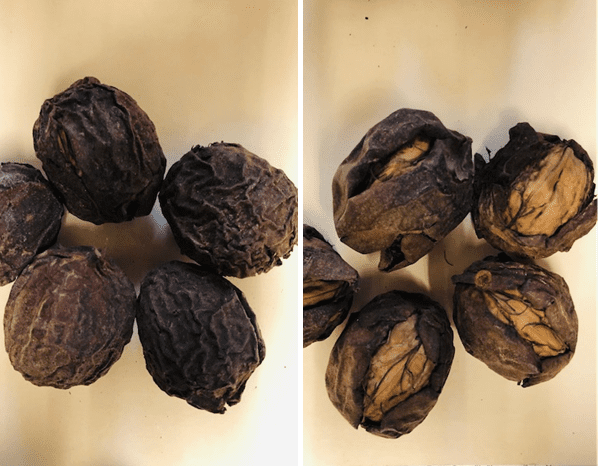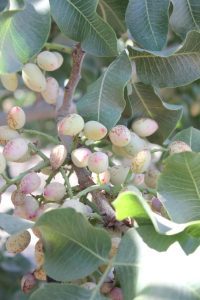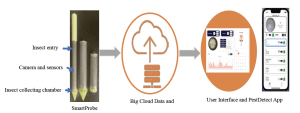
Consistently delivering a top-quality product to domestic and export markets is the goal of tree nut growers and processors.
To achieve that goal, they must determine how and why quality can be impacted during growth, harvest and processing. While still on the tree, quality challenges include insects, disease, nutrition and environmental. Processors maintain quality during handling and storage. Some of those challenges may be beyond grower or processor control, but research is showing proactive management can improve nut quality.
One of the best examples of meeting the insect damage challenge to nut quality is a good control program that takes into account pest pressure and is timed to achieve maximum control possible.
Environmental challenges are a tougher nut to crack.
The pistachio industry has been focusing on early detection of hull breakdown to give growers tools to avoid poor nut quality. Almond processors are looking at wireless technology to detect insect infestation in stockpiles and treatments to manage stockpiles. Walnut industry research is aimed at determining factors that contribute to dark kernels and mold.
In her Pistachio Day presentation, Barbara Blanco-Ulate, UC Davis plant pathologist, said predicting pistachio hull breakdown using biomarkers will allow growers to develop management plans to ensure nut quality. Optimal harvest timing can also help with costs, she said.
Biomarkers are molecular or physical signatures that can be measured in the field to anticipate large physiological changes like hull ripening and breakdown. Pistachio hull breakdown occurs after nut ripening and leads to higher nut susceptibility to insect infestation and fungal decay.
Blanco-Ulate said her California Pistachio Research Board-funded project led her to re-think nut growth stages. She noted that shell hardening and kernel growth happen at the same time. Hull ripening and kernel maturation start once the kernel reached the maximum size. There is also a peak in volatiles that happen just prior to hull ripening. Hull softening and hull coloration to red are reliable biomarkers of hull breakdown. Shell split occurs in parallel with hull softening.
Another finding in her research showed a faster hull breakdown in the Golden Hills variety compared to Kerman. At mid-August, Golden Hills had the highest level of VOCs, while Kerman VOCs peaked two weeks later at a much lower level. This faster rate of hull degradation leaves nuts open to insect damage and fungal growth and is the reason growers of this variety are urged to harvest early.
Blanco-Ulate and her research team also found that bloom time and temperature during early nut growth impact blanking and nut quality at harvest. Late bloom nuts have higher incidence of blanks and filled nuts without splits. With normal bloom, blank percentage was at 18%. Late bloom had 37% blanks. Normal bloom produced 94% shell split while late bloom looked had 55% shell split. Late bloom nuts have significantly harder hulls and softer shells. Blanco-Ulate also noted that it is not always the case that kernel expansion forces shell splitting. It is more than physical force, she noted.

Physical Measurements of Almond Quality
The almond industry is exploring genetics and chemical markers in kernels that contribute to taste and shelf life. Researchers are looking at kernel moisture, color, texture, lipids, tocopherols (vitamin E), cyanogenic glycosides and free amino acids.
The research study presented at the 2022 Almond Conference involved new experimental almond varieties and commercial varieties. One finding was that on average, the experimental varieties have higher levels of total vitamin E. This translates into longer shelf life, and greater nutritional value. Cyanogenic glycosides are responsible for almond bitterness and almond aroma.
Amygdalin is a cyanogenic-glycoside. Monitoring amygdalin in almond kernels and characterizing levels in almond hulls is critical for maintaining a safe, high-quality product and identifying safety of co-products.
Quality management at the processor involves early detection of insect pests in product storage. UC Davis researcher Zhongli Pan said at the Almond Conference that current chemical fumigation and product loss costs $350 million annually for tree nuts alone in the U.S.

Since 2021, he has been testing a new technology aimed at detecting insect infestations in stored almonds. Insect infestations can cause significant damage to stored almonds in a short time, Pan said. Infestations can occur quickly before they can be detected by humans. The SmartProbe technology, he said, is a novel tool for early detection of insect pests in stored commodities. Studies over the past two years showed it can detect insect infestations at an earlier stage than human inspection. One insect, he said, can damage 25% of kernels in a bin stored at 30 degrees Celsius. Insects found include navel orangeworm larvae and moths, red flour beetles, bugs and moths. The device measures temperature and relative humidity and monitors storage conditions.
Postharvest stockpile management of almonds and use of gaseous chlorine dioxide fumigation was explained by USDA-ARS researcher Vivian Wu. This fumigant reduced A. flavus mold and toxins on stockpiled almonds with no significant effect on almond quality. She said gaseous CO2 can be used for moisture pockets and moisture exposed product. It does not require on-site storage of gas cylinders and no certification for application is required. This chemical can be modified on the company’s required treatment method for storage, stockpile or silos.
Walnut Challenges
In walnuts, sunburn, irrigation management and disease prevention can determine kernel quality at harvest.
Dark kernels, shriveled kernels and mold are quality defects that cause processor rejections.
Producing light-color kernels is important in the walnut industry. Robert Verloop, executive director of California Walnut Board and California Walnut Commission, said at the UC Tri-County Walnut Day. Light-color kernels give handlers more flexibility in marketing as they can be held for a longer period.
Environmental conditions in walnut orchards cannot always be mitigated as evidenced by the summer 2022 heat wave that caused serious nut damage in many northern growing regions. Very high temperatures at critical times in nut development caused hulls to adhere to shells. These ‘black hull’ nuts were rejected at the hullers.
UC Plant Pathologist Bruce Lampinen, in a presentation at the Tri-County Walnut Day, highlighted the walnut quality studies that have taken place over many years. They included quality and kaolin application studies and impacts of excessive irrigation on quality. One of the findings was nuts that have hulls that do not split normally and maintain wet conditions around the kernel cause quality problems.
Nuts continuously exposed to the sun have husks that develop dark brown leathery lesions by mid- or late summer. Sunburned nuts have shriveled and darkened kernels. Lampinen said field trials showed most sunburn occurred in southwest-oriented lower positions where there was an indentation in the canopy, likely leading to lack of air circulation. Kaolin, which is applied to prevent sunburn, needs to be applied where nuts are exposed to mid-day sun.
Lampinen noted timing of stress has different impacts on quality. Stress during kernel filling, typically in July and August, impacts kernel size. Stress at hull split can impact kernel color.
Water availability and uncertainty and warmer summer temperatures will continue to challenge walnut quality statewide, Lampinen said.

Cecilia Parsons | Associate Editor
Cecilia Parsons has lived in the Central Valley community of Ducor since 1976, covering agriculture for numerous agricultural publications over the years. She has found and nurtured many wonderful and helpful contacts in the ag community, including the UCCE advisors, allowing for news coverage that focuses on the basics of food production.
She is always on the search for new ag topics that can help growers and processors in the San Joaquin Valley improve their bottom line.
In her free time, Cecilia rides her horse, Holly in ranch versatility shows and raises registered Shetland sheep which she exhibits at county and state fairs during the summer.















